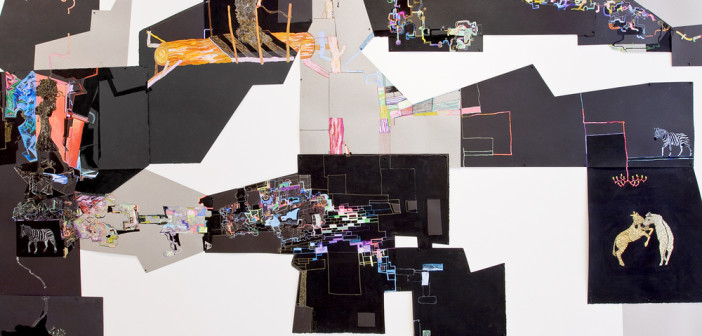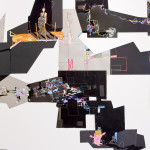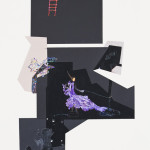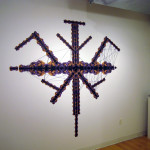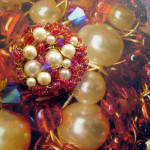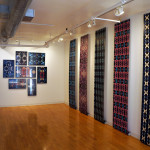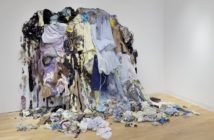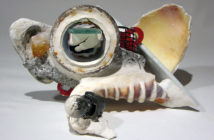The most obvious benefit of belonging to an artist-run, coöperative gallery is stability regardless of commercial success. Artist-members can count on regular solo shows, and have no limitations when choosing what to exhibit, or how to present it. Reliable deadlines provide impetus to an often solitary and disconnected studio practice, and the grounded quality of the environment should compel each artist to tackle new conceptual and formal questions in the two years that pass between shows. Absolute freedom, and the luxury of stability, can turn into a hindrance, however, so the model needs improving. Spaces such as Boston Sculptors and Kingston Gallery have the freedom to eschew commercial models for something closer to those of 'project spaces,' which can nurture opportunities for members to experiment, collaborate, curate, and create a supportively critical climate privileging (written and verbal) exchange and debate. Peer-review might not just be reserved for the initial membership evaluation process, but find itself applied to exhibition planning, rather than adding further structure, to allow for more daring kinds of presentation.
 Ilona Anderson
Ilona AndersonWhat One Is, 2013
Pearlescent ink, Lascaux acrylic, gouache on black and grey archival papers
38 x 78 inches
The two exhibitions on view currently at Kingston Gallery offer a good opportunity for this conversation. They also merit a critique. Both artists are taking risks, yet seem begging to be told it's ok to jump off the ledge, something I'm arguing is partly incumbent on their peers. Ilona Anderson's drawn installation, What One Is, presents assemblages of cut paper, within which nest brightly illustrated vignettes. The technique isn't new to her, though here she boldly conquers two-thirds of the gallery space with friezes that read like rambling sentences full of non sequitur. As both a literary and formal device this remains conservatively reminiscent of André Breton, Yves Tanguy & co.'s exquisite corpse technique, and perhaps most of all of Max Ernst's surrealism—Anderson's highly adorned female figures bear some resemblance to his bird-women. A century later, this self-consciously archetypal imagery feels pretty tame for dreamland, and fails to clearly evoke the conflicted territory Anderson states inspired it—South Africa under apartheid, with which she is personally familiar. As a bicultural artist, I can fully relate to the lingering presence of past experience, to the sense of feeling divided, never quite at home in either place, while wanting to simultaneously stake and retain one's claim on each. Most often, we awaken these tattered memories of homelands while we sleep. But I feel like someone should free this artist from the weight of a collective political past, which she doesn't need to carry for the nation if she really prefers to go nuts with her fantastical dancing zebras.
There are formal parallels between Anderson's cut papers, apposed and pinned in angular groupings, and the Gallery's actual infrastructure. This is echoed further within the drawings themselves through accumulations of rods and pipes that bend and twist around each other. It wasn't clear to me whether she had foreseen these parallels, but it seems like Kingston Gallery itself is place where the installation could eventually take root and ripen. A more urgent challenge is the flatness inherent in the paper surface and how that is contradicted by its blackness. If operating in a timeless void, freed from gravity and logic, why be constrained by the linear and two-dimensional qualities of the medium? Each vignette is wanting in depth and motion. As it is, the installation quickly becomes repetitive, rather than drawing one in, because Anderson never fully toys with spatial rhythm, a push-pull that could be evoked through varied perspectives, close-up and long-distance views. What One Is sounds like it wants to be an opus, and my strongest recommendation to the artist, along with exploring personally challenging and diverse imagery, is to let in more multidimensional lyricism, such as in cinema, music, theater, and dance. Dreams are rarely comfortable.
 Karen Meninno
Karen MeninnoIteration II, 2013 (detail)
Digital Image on vinyl wall decals, bead and thread sculpture
74" x 74" x 2"
in "Sculpture Remix II"
In the smallest of the spaces, Karen Meninno is concluding her solo exhibition from last month, Sculpture Remix, with a spur-of-the-moment installation. This last minute opportunity to occupy the gallery is perhaps what lead to her most daring work yet. It made me sorry to have missed the main event, though I suspect this reduced show is even better. Until now, I will admit, I was no great fan of Meninno's work, which I found visually precious, and pretty loose conceptually. In Sculpture Remix I & II, she has set herself the challenge of seeing whether her sculpture retains its inherent properties if transformed into two dimensional images. It was a smart decision for her to lead with a formal question, rather than follow a symbolic line of inquiry. The resulting works are surprising, not simply in their abstraction of the original object, but because of the way they are starting, in this second iteration of the show, to upset the photographic symmetry and morph back into three dimensional pieces.
Based on the photographs I have of Sculpture Remix I, it appears Meninno began with simple repetition and mirroring effects, creating kaleidoscopic, symmetrical compositions. Allowing the technique to dictate the form performed a complete metamorphosis on the original object, and, even if the resulting images still remained excessively decorative and controlled, it was a freer gesture than she'd allowed herself until then. These latest experiments—that's my excitement talking—are really beginning to take off. Iteration II repeatedly shifts the scale of a single image as it generates a colony of itself: the wall is host to a self-referential organism in the process of replication. By reintroducing the source object, and by adding tactile materials on top of the images, Meninno has begun adorning the adorned, leading to a probable overdose of kitsch that is dizzying. I hear a crazed voice rambling in its own sampled language. Now this is what a space like Kingston Gallery could do best: secure in the knowledge that there is a safety net to catch them, let's see some more leaps into the void.
- Ilona Anderson, What One Is, 2013 Pearlescent ink, Lascaux acrylic, gouache on black and grey archival papers 22 x 30 inches
- Ilona Anderson What One Is, 2013 Pearlescent ink, Lascaux acrylic, gouache on black and grey archival papers 38 x 78 inches
- Ilona Anderson What One Is, 2013 Pearlescent ink, Lascaux acrylic, gouache on black and grey archival papers 38 x 78 inches
- Karen Meninno Iteration I, 2013 Digital Image on vinyl wall decals, bead and thread sculpture 74″ x 74″ x 2″ in “Sculpture Remix II”
- Karen Meninno Iteration II, 2013 (detail) Digital Image on vinyl wall decals, bead and thread sculpture 74″ x 74″ x 2″ in “Sculpture Remix II”
- Karen Meninno, Sculpture Remix I, 2013

